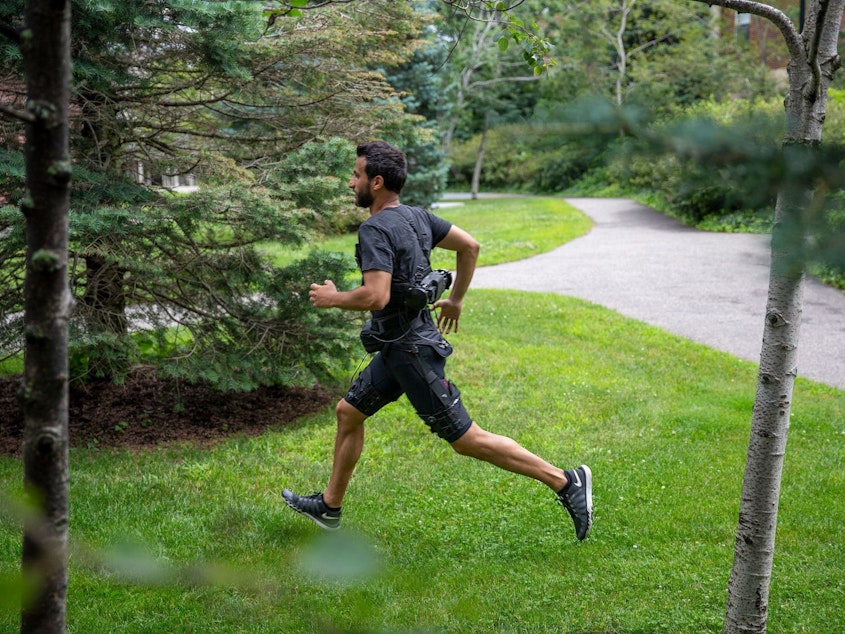These Experimental Shorts Are An 'Exosuit' That Boosts Endurance On The Trail

Say the word "exosuit" and superheroes come to mind — somebody like Tony Stark from Marvel Comics, whose fancy suit enables him become Iron Man.
But scientists at Harvard University have been developing an actual exosuit — a wearable machine that they say can improve a mere mortal's strength and stamina. This new prototype is novel because it improves a wearer's performance while walking and running — just one example of progress in what's become a surging field.
This suit looks kind of like bike shorts, with some wires and small machines around the waist, and cables down the legs. When it's turned on, a person expends less energy when moving.
"Essentially, we've kind of recreated an artificial muscle on the outside of the human body that's working in parallel with the underlying biological muscle," explains lead researcher Conor Walsh, an engineering professor at Harvard.
Take a look at the suit in action:
Walsh says when you put on his team's suit, "you definitely notice that it's pulling across your joints, so you feel, kind of, the small tugs from the cable. But after a fairly short while — maybe like five minutes — you don't really notice it anymore."
The suit helps to extend the hip joint, saving the user energy. And though you might not notice it, when you shut the suit off after a few minutes of having it turned on, Walsh says, "you really quickly notice that your legs feel a little bit heavier, and you feel a little bit more sluggish."
Designing such as suit has been a challenge, Walsh says, because the strides taken during walking and running are fundamentally different motions — so the machine has to be able to sense when someone wearing the suit changes their gait.
"The person doesn't have to tell the system to do anything," Walsh says. "It just automatically switches between those two modes." The suit uses sensors and a "biologically inspired gait classification algorithm" to change modes.
The suit weighs about 11 pounds. The team's research, published Thursday in the journal Science, finds that a person wearing this suit expended 9.3 percent less energy walking and 4 percent less energy running, compared to wearing no suit.
That's the equivalent of shedding 16 pounds of weight while walking, or 12 pounds while running.
Walsh says he thinks this suit could be helpful for a soldier carrying heavy weights over long distances. Research on the suit was supported by the Defense Advanced Research Projects Agency, which is part of the Defense Department and develops military technology.
Someday, Walsh says, it might also put some pep in the step of an average weekend warrior. The idea, he adds, would be "helping healthy people move more efficiently --[which] could be someone who's a recreational hiker who wants to have a little bit more endurance."
Other future models might help people with medical issues such as multiple sclerosis or Parkinson's disease to move more easily, he says. His lab collaborates with a company on a suit to help stroke survivors that is now commercially available.
Karl Zelik, a mechanical engineering professor at Vanderbilt University who was not involved in the study, calls the team's effort "promising work."
"This study represents a nice integration of wearable hardware and control algorithms, and adds to the growing enthusiasm and momentum behind assistive exosuits for augmenting human capabilities during various aspects of daily life," Zelik says. "This is one of the first wearable robotic devices that has demonstrated walk/run mode-switching in a scientific publication."
Walsh notes that the exosuit field is changing fast. In the future, he says, the best assist devices may not be exosuits at all, but rather technology implanted inside a person's body.
In an accompanying article in Science, José Pons of the Spanish National Research Council predicts that future wearables will be implantable and able to "decode the wearer's movement intent, and influence it when necessary to enhance human performance." [Copyright 2019 NPR]



